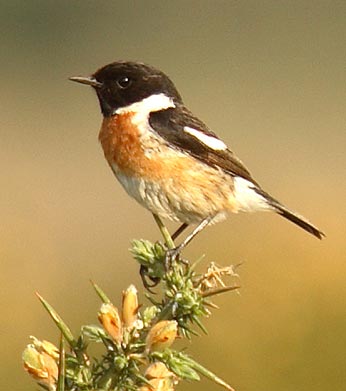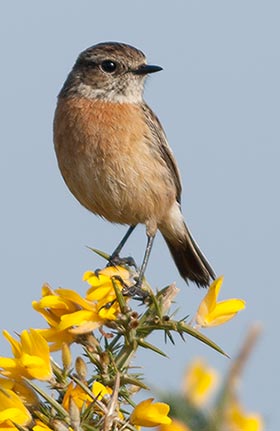Stonechat (Saxicola torquata)
When: All year round
How many: Reasonably abundant

atop a gorse bush
William Wordsworth called stonechats ‘restless birds’ and he was absolutely right, for they are rarely still. Ever alert, these vigilant heathland sentinels can be relied upon to sound the alarm at the merest hint of danger.
Unlike their near neighbours, the Dartford warbler and woodlark, stonechats really like to be noticed. Indeed, stonechats are probably the most prominent birds of the New Forest heaths, and can usually be readily seen, even from some considerable distance.
Closely related to the robin, stonechats are dumpy little creatures around 12 centimetres (5”) long, and with the robin’s body shape and outline. Male stonechats in breeding plumage are handsome creatures, pale below but with strikingly reddish-orange breast; black head, throat and back; and with bold white patches on neck and wings. Female stonechats, though, are altogether duller, with paler, less striking breast colours combined with browns and other nondescript shades.
Stonechat song, most often heard in the breeding season, is a jumbled, somewhat melancholy mixture of warbled notes, whilst the alarm call is a harsh, oft repeated chakk-chakk-chakk that sounds remarkably like stones being knocked together – hence the name.
Locally, however, stonechats were also known as furze (gorse) hackers, which is a marvellously descriptive name that also fits them well.

are fond of perching on the
highest sprigs of gorse
Although sometimes seen spiralling upwards whilst chasing airborne insect prey, stonechats more often like to drop down from a perch onto reasonably open ground on which their next tasty meal has been spotted - the New Forest’s heavily grazed, short-cropped grass and recently burnt areas serve this purpose well.
Stonechats take small to medium sized insects and other invertebrates, including caterpillars, butterflies, grasshoppers and damselflies.
Stonechats are partial migrants that are usually present in good numbers in the New Forest from late-winter through to late-summer or early autumn. Many stonechats, though, stay longer, and in some years, quite large numbers over-winter, driven away only by the harshest of weather.
Low level stonechat movements across the heaths can be noticed from July, when what are presumably family parties can be seen progressing steadily onwards, stopping to feed as they travel. Indeed, at this time, some turn up on adjacent grass and agricultural land.
On the coast, increasing numbers of Stonechats are often present from September, whilst many of the birds continue on to France and places beyond in southern Europe.
Those stonechats that remain over winter, often do so in pairs – if a single stonechat is seen, there is a good chance that its mate will be present somewhere nearby. Pairing is not, though, often thought to be for life.
In the New Forest, stonechat numbers are currently relatively high, encouraged by recent mild winters. Indeed, long term trends show a steady rise, interrupted only by declines coinciding with colder weather.
References:
The Shell Guide to the Birds of Britain and Ireland: James Ferguson-Lees, Ian Willis and J.T.R. Sharrock
Birds of Hampshire: Hampshire Ornithological Society
Hampshire Bird Reports: Hampshire Ornithological Society
Handbook of the Birds of Europe, the Middle East and North Africa, The Birds of the Western Palearctic (volumes 1-9): Stanley Cramp, et al
The New Atlas of Breeding Birds in Britain and Ireland (1988-91): D.W. Gibbons, J.B. Reid and R.A. Chapman
The Migration Atlas: British Trust for Ornithology
All the Birds of the Air: Francesca Greenoak
More links
Other related links
Search this site

Sadly, 58 animals were killed - 35 ponies, 13 cows, 8 donkeys and 2 sheep, whilst a further 32 were injured - 3 pigs, 9 donkeys, 11 cows and 9 ponies.
(Forty-three accidents occurred in daylight, 15 at twilight and 101 in the dark. Twenty-seven accidents were not reported by the driver involved).
Here's just one horrific example - Three donkeys killed in collision with van at notorious New Forest blackspot (Advertiser and Times)

